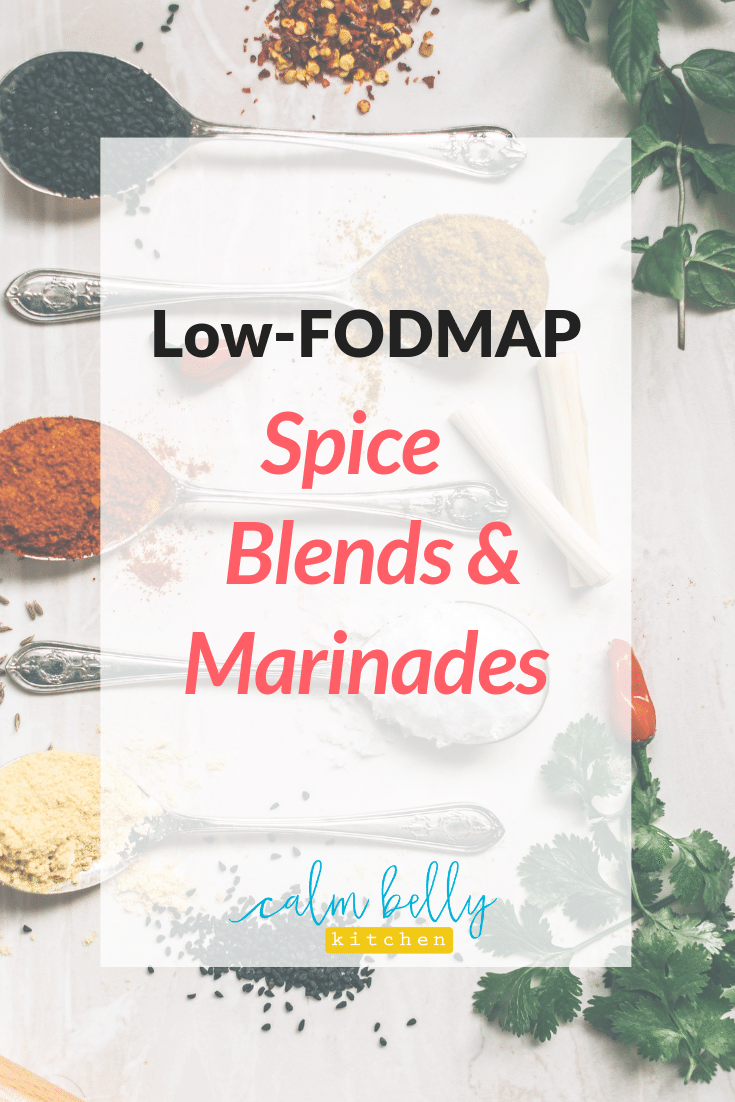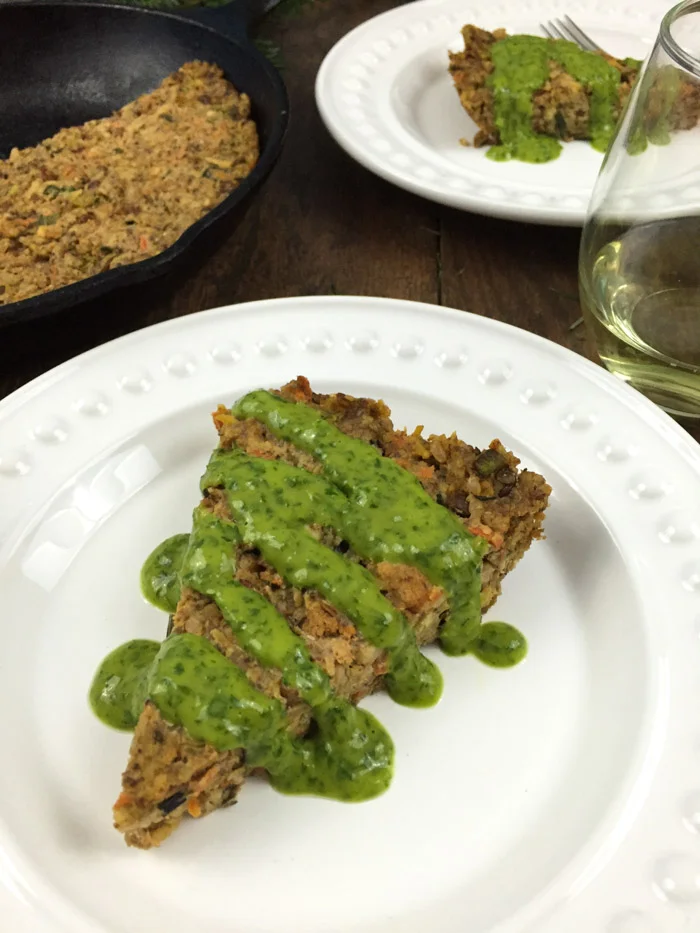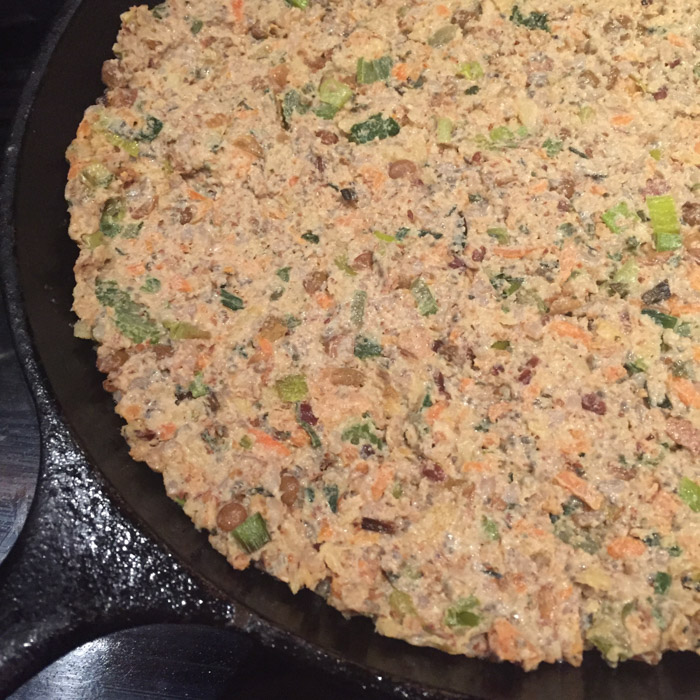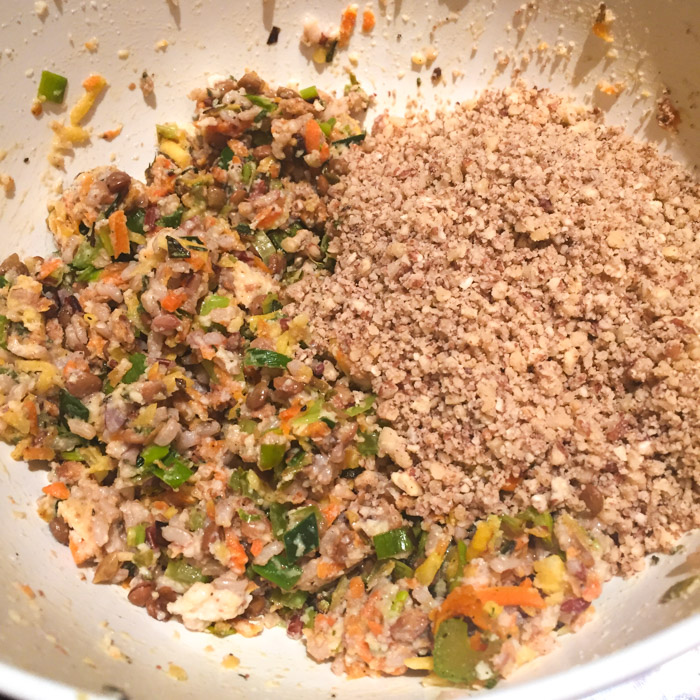Thought a low FODMAP Buddha Bowl was impossible? Not so! This IBS-friendly recipe is hearty, colorful, and packed with nutrients...and you'll love the sticky sesame sauce. Time to hop on the trend with this sesame chicken Buddha Bowl!
Grilled Steak with Chimichurri Sauce (low-FODMAP recipe)
Grilled Steak with Chimichurri Sauce (low-FODMAP recipe)
Save it on Pinterest!
Chimichurri is a sauce from Argentina made with fresh herbs and typically served over grilled meat. Since the sauce is uncooked it’s not only a snap to make, but the perfect summer condiment.
Chimichurri should be renamed “magic sauce,” because it’s magically delicious on just about anything. I’ve used it on:
Grilled steak, pork chops, and chicken breasts
Grilled fish and shrimp
Sandwiches
Eggs
Rice bowls
Tacos
If you’ve been to an Argentinian steak house, you’ve likely had chimichurri. The classic recipe includes a good amount of raw garlic, which I never liked (before the FODMAP Diet, I would actually cook the garlic before adding it to the chimichurri).
Luckily, the sauce is just as good sans garlic. In my opinion, it’s better. If you love garlic flavor, substitute garlic infused oil for 1 to 2 tablespoons of the olive oil.
You’ll also find my recipe for roasted potatoes below, which is a typical side for an Argentinian grilled meal. The potatoes couldn’t be simpler, but I like to think I’ve perfected the method over the years to make the perfect roasted spuds. :-)
Looking for more low-FODMAP grilling recipes? Check out Lemon-Caper Fish and Veggies Grilled in Foil Packets and Caprese Salad with Grilled Eggplant!
Grilled Steak with Chimichurri Sauce
If you prefer sirloin or another cut of steak, go for it! The recipe calls for bone-in NY strip because that’s what I used, but boneless is great too. The sauce is also delicious on grilled pork, chicken, and fish. To use as a marinade, add extra olive oil and/or lime juice to thin.
Serves 4 - Makes about ¾ cup sauce, double recipe if needed (1 serving = 3 tbsp)
INGREDIENTS
1 cup (packed) parsley (leaves and thin stems)
1/4 to 1/3 cup mint leaves (about 4 sprigs)
1 tbsp red wine vinegar, plus additional if needed
1 lime, juiced
¼ cup extra-virgin olive oil, plus additional if needed
2 tsp Dijon mustard
1 tsp granulated sugar (or your sugar of choice)
1/2 tsp red chile flakes, or to taste (optional)
Sea salt to taste (1/4 to 1/2 tsp)
Freshly ground black pepper to taste
2 lbs bone-in New York strip (see note above)
INSTRUCTIONS
1. Add parsley and mint to a food processor and blitz until finely chopped, scraping down bowl as needed. Add vinegar and lime juice. With processor running, slowly pour olive oil through the feed tube.
2. Add mustard, sugar and chile flakes if using. Season with salt and pepper. Pulse until blended. Consistency should be thick but pourable. Add additional oil or red wine vinegar to thin, depending on whether you like more or less acidity. Check seasoning. Can be used as a marinade, or served over grilled meat or fish. May be stored in the refrigerator up to 2 days. Serve at room temp.
3. Prepare a charcoal or gas grill (high for gas) and brush grate with oil. Season steaks with salt and pepper. Grill steaks over direct heat, turning once or twice, until done to your liking, 10 to 12 minutes for medium rare (130F to 135F). Rest at least 5 minutes. Slice and serve family style drizzled with chimichurri sauce.
Roasted Potatoes
Serves 4
Cooking spray
2 lbs yellow potatoes, cut into 1-inch chunks
1 to 2 tbsp olive oil
Salt and freshly ground black pepper to taste
1. Preheat oven to 400F. Line a large, rimmed baking sheet with foil (optional, to minimize clean up) and coat with cooking spray. Add potatoes and drizzle with oil. Season with salt and pepper and toss to coat.
2. Roast until potatoes are golden brown and very tender with pierced with a fork, tossing 2 times during cooking, 35 to 45 minutes.
Looking for FODMAP Recipes? Making Your Favorite Foods Low-FODMAP
Ultimate Guide to Making Your Favorite Recipes Low-FODMAP
You've Gotta Pin This One!
I love a good makeover (any What Not To Wear fans in here?), but even more than the fashion and style stuff, I love a recipe makeover.
Want proof? Here you go…
Yup, for over 3 years I wrote a monthly column for Clean Eating magazine where I revamped classic recipes to make them healthy and (obviously) clean. I loved this gig. But just because a recipe’s healthy doesn’t mean it’s IBS-friendly.
Lucky for you, making over your favorite foods into FODMAP recipes is NOT as hard as it seems. And you don’t need any ninja-chef skills to do it.
Psst >>> If you want to start the FODMAP Diet but feel overwhelmed, I created a FREE email course to ease you into it and give you the tools you need to succeed.
Click to sign up for the Free 7-Day FODMAP Jumpstart Challenge!
Why Recipe Makeovers?
It’s absolutely essential that you learn to make some of your favorite dishes low-FODMAP. Why? Because one of the biggest reasons people stumble in the first phase of the FODMAP Diet - the Elimination Phase - is the fear and sadness over giving up the food they love.
(I know this from experience - I wasted months before I finally did the Elimination Phase because giving up food was too sad.)
In this post, I’m laying out the best tips, tricks, strategies and substitutions I know to develop crave-able, drool-worthy FODMAP recipes. It's the foundation of the Calm Belly Kitchen Cookbook. And it’s how I got myself through the FODMAP Diet with zero deprivation.
This epic list of makeover strategies starts with simple swaps and progresses to mini recipes and creative flavor tactics.
Before you dive in, watch the video to see some of my personal favorite recipe makeover strategies and substitutions (If you love Italian and Mexican food, it's a must-see.). Then read the post with YOUR favorite recipes in mind.
If you remember one thing, make it this: Eating great food that you love is so do-able on the FODMAP Diet, and you’re not being sentenced to food prison without parole.
1) Replace Onion With Leek Tops: The green part is low-FODMAP, while the white part is high. Leeks have more flavor than onions, and you won’t cry when you cut them. Scallion tops are great too. The picture below show what part of the scallion or leek to use. Watch this video to learn how to wash leeks!
2) Replace Garlic With Garlic-Infused Oil: FODMAPs are water soluble, which means they soak out into liquids, but NOT fats. That’s why garlic oil is low-FODMAP. For the boldest flavor, add it at the end of the cooking process.
3) Build Flavor With Anchovies: At the start of the cooking process (when you’d normally sauté onion or garlic), sauté 1 tbsp anchovy paste or 2 to 3 oil-packed anchovies on medium heat in some olive oil.
4) Use Miso: Do the same thing as above with 1 to 2 tbsp of miso paste (especially good in soups and stews)
>>> This blog post has even more ways to replace onion and garlic and add big flavor to your recipes: The Ultimate Guide to Flavor Without Onion and Garlic
5) Add Bacon: It's the time-honored method for making any recipe irresistible.
6) Replace Mushrooms With Eggplant: The texture is similar, and it’s great sautéed, roasted or grilled.
7) Buy Chile Powders With 1 Ingredient: Some products called “chile powder” are blends that often include onion and garlic, which are high-FODMAP. Instead make sure yours only contains chiles. Ancho chile powder is mild and incredibly flavorful.
8) Substitute lactose-free milk anywhere you’d use regular milk: This is real cow’s milk treated with an enzyme to remove the lactose so it works just like regular milk in recipes.
9) Swap Your Veggies: Replace onion and celery with diced or grated carrot, celery root, leek, and/or red bell pepper (works great in recipes that call for the “holy trinity” of onion/celery/carrot)
10) Replace Ketchup: Many commercial ketchups contains high-fructose corn syrup and occasionally honey (both high-FODMAP)...but you've got options.
Instead of ketchup, toss your oven fries with lemon zest, chopped parsley and garlic-infused oil - delish!
Do as the English do and dip fries in mayo (get fancy and mix in Dijon mustard, hot sauce, parsley, or lemon zest)
11) For Mexican Food
Use canned lentils to make refried beans - here’s my recipe!
Replace onion-y garlic-y salsa with my EASY CBK Salsa that you can make in the food processor
Replace flour tortillas with corn tortillas
Replace onion with carrots, leeks and/or red bell peppers in casseroles and soups. Rice Casserole
What low-FODMAP really looks like! Polenta Lasagna, Cobb Salad with Blue Cheese Dressing (both from CBK Cookbook) and Huevos Rancheros.
12) Replace Chicken Broth: The store-bought stuff is SO convenient, but have you ever tasted it straight? Not all that flavorful. Instead, use water and add some of these flavor boosting ingredients:
Miso paste
Anchovy paste
Dried herbs and spices
Wine
Lemon juice and soy sauce (a killer combo)
Fish sauce
> But wait! Massels brand is onion/garlic-free.
13) For Marinades: Omit the onion and/or garlic - it will still do the job! Try this easy favorite of mine:
Citrus-Herb Marinade
3 green scallion tops
Handful parsley leaves and stems (about 1/2 packed cup)
2 tbsp dijon mustard
1 tbsp hot sauce (optional) - here’s my fave low-FODMAP brand
1/2 tsp fish sauce
2 tbsp lemon juice
3 tbsp orange juice
2 tbsp rice or red wine vinegar
2 tbsp olive oil
Put all ingredients through vinegar in food processor and blitz. With processor on, slowly pour oil through feed tube. This marinade is great with just about anything, especially chicken and fish.
14) Make Your Own Spice Blends - Most store-bought blends contain onion and/or garlic powder. You can play with the amounts or add other spices you like. I promise, you can’t mess this up. Here’s a simple blend to start with (great for chicken and pork):
Mild Mexican Spice Blend
1 tsp ancho chile powder
1 tsp cumin
1⁄2 tsp coriander
1⁄2 tsp dried oregano
For Italian Recipes
15) Make Your Own Tomato Sauce:
Sauté chopped leek tops (the green part) in olive oil
Add dried herbs and/or chile flakes
Add ½ cup red wine and reduce (optional)
Then add 1 can tomato sauce and 1 can diced tomatoes
Simmer until slightly thickened
Turn off heat and add fresh basil and garlic-infused oil to taste
Tip: A low-FODMAP serving of canned tomatoes is 1/2 cup.
16) Replace Pasta With Polenta or Risotto: There are some great gluten-free pastas out there too! My favorites are Jovial and Trader Joe’s brand.
17) For Pizza: Buy or make a low-FODMAP crust and top it with your homemade sauce (or do a white pizza with béchamel sauce - see the third idea below)
Three of my favorite topping ideas:
Mozzarella, prosciutto, roasted eggplant, goat cheese
Mozzarella, ground turkey, sautéed spinach, feta
Mozzarella, parmesan, sliced scallops, topped with arugula when it comes out of the oven (great with béchamel sauce)
18) Replace Cream Sauce With Low-FODMAP Béchamel: Here’s my easy recipe, and you can scale it up:
Low-FODMAP Béchamel Recipe
Heat 1 tbsp butter or oil in a small saucepan on medium-low
Add 1 tbsp gluten-free flour blend (must be free of gums, such as this one) or rice flour and stir until combined, about 1 minute
Add 1 cup lactose-free milk and raise heat to medium high
Whisk constantly, breaking up any flour clumps until milk comes to a simmer and sauce thickens
Remove from heat and season with salt and pepper plus any herbs and spices you want
Use it for:
Cream soups like chowder
Cream sauces like Alfredo
Creamed greens
White pizza
Any recipe that calls for béchamel
19) Replace Creamy Dressings: It’s crazy-easy to make your own with lactose-free plain yogurt or kefir - the amounts are flexible, you can’t mess this up. Here’s an example:
Blue Cheese Dressing Recipe
Tip: Make it a Ranch dressing by swapping the blue cheese for parmesan and adding fresh chives and/or scallions.
3⁄4 cup lactose-free yogurt
3 tbsp lactose-free milk, plus more as needed
2 tbsp lemon juice
1 tbsp nutritional yeast (optional)
1⁄4 tsp sea salt
Freshly ground black pepper to taste
1⁄3 cup (about 1 1⁄2 oz) crumbled blue cheese
2 scallion tops, finely chopped
Stir together all ingredients. Add extra milk if you want a thinner consistency.
20) Learn the Cheese Trick!
Plenty of cheeses are low-FODMAP, but not every possible variety has been tested by Monash yet. Here’s how to tell if a cheese is low in lactose:
1) Check the ingredients: If added sugars or high-FOMDAP ingredients like honey or garlic (this is common in cheese products or flavored cheeses, not so much in natural cheese). If it’s got ingredients added, this trick doesn’t apply.
Natural cheese DOES include things like: milk (or pasteurized milk), salt, cultures, enzymes, and possibly preservatives or natural colors.
2) Look at the Nutrition Facts. Go to the “sugars” line (lactose, the FODMAP you want to avoid is a sugar). If it contains 0 grams sugar, the cheese is either lactose-free or so very low in lactose that only an extremely sensitive person would have issues (in the US, if the sugar totals < 0.5 gram, manufacturers can round down to zero)
And that's a wrap! 20 cool, creative, delicious ways to makeover your favorite recipes. You don't have to give up everything yummy to do the FODMAP Diet, so don't let fear of missing out on great food hold you back from a calm belly.
What recipes are you going to makeover? Have questions? Leave a comment and let me help!
This post contains affiliate links.
Vegan Nut & Veggie Tart with Green Herb Sauce (Low-FODMAP, Gluten Free, Dairy Free)
Vegan Nut & Veggie Tart with Green Herb Sauce (Low-FODMAP, Gluten Free, Dairy Free)
Ah, holiday cooking. So many dietary needs to take care of. Enter the vegan tart. This recipe is for you if…
You're a vegan or vegetarian.
You're cooking for vegans or vegetarians sometime soon.
You want a crazy-nutritious meatless main dish for the holidays.
But let me backtrack for a second. This recipe came about through an informal collaboration with Alana, the very talented writer behind the blog, A Little Bit Yummy.
She had a lot of readers asking for a vegan nut loaf recipe to make for the holidays. However, being allergic to nuts, she asked if I'd be interested in developing the recipe.
My answer: Heck, yes!
Through the past 9 years of doing freelance recipe development, some of my favorite jobs have been the ones that are different from my personal eating style. Stretching that creative muscle is always a good idea: It's both fun and mentally engaging!
Let's get into the details...
Here's what the ingredients look like before stirring in the nuts and right before going in the oven. Everything stays super-moist, without any crumbling.
Here's why I think this is the vegan recipe you need to try this season:
It won't weigh you down. Some vegan nut loaves have the heft of a hockey puck and come in at 1,000 calories per serving (it happens!). Not this tart. Instead of mostly nuts, this recipe consists of brown rice, lentils and a bunch of winter veggies. It will make your kitchen smell like Thanksgiving.
The sauce. The sauce alone is a gem. With the creaminess of avocado and a tangy hit of lemon, you'll want to eat it straight. Double the recipe if you want; whip it up anytime you've got extra herbs on hand; put it on everything!
It's not a loaf, it's a tart! If you've never found the look of traditional vegan nut loaves all that enticing, this pretty tart is the answer.
No advanced cooking skills. There are quite a few steps to get all the components together, but they're easy-peasy. Plus, you can do some or all of it ahead if you want.
Freedom of choice. If you really want to make a loaf, this recipe should fit in 2 standard loaf pans. But there are other fun possibilities: Use a muffin tin to make individual servings for a potluck or buffet. Use mini muffin tins to make appetizers (cute!)--just be sure to decrease the baking time. I love baking in my cast iron skillet because it looks great at the table, but a pie plate or similar-sized baking dish will work too.
So are you convinced? I'd love to know how many of you follow a vegan or vegetarian diet. Do want to see more recipes like this? Will you give this one a try? Let me know below in the comments!
Vegan Nut and Veggie Tart with Green Herb Sauce (Low-FODMAP, Gluten Free, Dairy Free)
A cast iron skillet is great for baking this rustic tart, but any oven-safe 9-inch pan will work, as well as any similar-size baking dish, such as a pie plate. If you use a baking dish, I recommend greasing it with butter or ghee as noted in the recipe. The easiest way to shred the carrot and parsnip is with a food processor with a shredding disk. If you don't have this attachment, you can grate them on a box grater or cut into very thin strips (julienne) with a knife.
Author: Julie-Calm Belly Kitchen Recipe type: Entrée
Prep time: 50 mins Cook time: 25 mins Total time: 1 hour, 15 mins
Makes 8 servings
INGREDIENTS
For Tart:
2 tbsp olive oil, divided
3/4 cup (84g) walnuts
3/4 cup (84g) pecans
1 medium carrot, peeled and shredded (about 1 cup/85 g shredded; see note above)
1 medium parsnip, peeled and shredded (about 1 cup/85 g shredded; see note above)
½ tsp dried rosemary
½ tsp dried thyme
Salt and freshly ground black pepper to taste
1 medium leek, green part only, chopped (about 1 cup)
1 rib celery, diced (about 2/3 cup)
¾ cup (105 g) cooked brown rice
2/3 cup (92g) rinsed and drained canned lentils
3 small slices (75g) low-FODMAP, gluten-free bread
1 cup unsweetened almond milk
1 tbsp chia seeds
Nonstick cooking spray, butter or ghee for greasing your pan (see note above)
For sauce:
1 cup (packed) mixed parsley and cilantro (leaves and thin stems)
¼ avocado, chopped
2 tbsp lemon juice (from 1 lemon)
1 tsp Dijon mustard
1 tsp hot sauce (optional)
3 tbsp extra virgin olive oil
¼ to ½ cup water
Salt and freshly ground black pepper to taste
INSTRUCTIONS
1. Preheat oven to 350F. Spread walnuts and pecans on a large, rimmed baking sheet and bake until fragrant and light golden brown, 7 to 8 minutes, stirring them around about halfway through. Transfer to a plate and set aside until completely cool (I like to do this a day or two ahead of time). When cool (otherwise they can turn into a paste), finely chop in a food processor fitted with the metal blade.
2. If the shredded carrots or parsnips are very long, roughly chop so pieces are no longer than 1 inch. Heat 1 tbsp of the oil in a large skillet (if you'll be baking the tart in a 9-inch oven-safe skillet, you can use that) on medium. Add the carrot, parsnip, rosemary, thyme, and salt and black pepper to taste. Cook, stirring frequently, until tender and lightly browned, 5 to 7 minutes. Transfer to a large bowl.
3. Add remaining 1 tbsp of the oil to the same skillet and heat on medium. Add leek, celery and salt and pepper to taste. Cook, stirring frequently, until tender and light golden brown, 6 to 8 minutes. Add to bowl with carrot mixture. Add the rice, lentils and chopped nuts and stir until combined.
4. Place the bread in a shallow bowl or small baking dish in a single layer. Add the almond milk and allow the bread to soak until very soft but not dissolving, about 5 minutes, turning once. Tear into small ½-inch pieces and add to bowl with veggie mixture (discard remaining almond milk). Stir until combined.
5. In a small bowl, stir together the chia seeds and 3 tbsp warm water. Set aside until mixture thickens to a gel-like consistency, about 5 minutes. Add to bowl with veggie mixture and stir until combined. Taste for seasoning and add extra salt, pepper or herbs (or other spices) as desired. Coat a 9-inch oven-safe skillet (such as cast iron or stainless steel) with nonstick cooking spray; or coat a 9-inch pie plate or similar-size baking dish with butter or ghee. Add veggie mixture and pat into an even layer. Bake at 350F until slightly puffed in the center and lightly browned at the edges, 25 to 30 minutes.
6. Make the sauce: In a food processor fitted with the metal blade, combine herbs, avocado, lemon juice, mustard and hot sauce if using. Pulse until herbs are chopped, scraping down the bowl as needed. With processor running, slowly pour the olive oil in through the feed tube, followed by ¼ cup of the water. Scrape down the sides of the bowl. Add more water as needed until the sauce is thick but pourable (you should be able to drizzle it off a spoon). Season to taste with salt and pepper.
7. When tart is done baking, cool for 10 to 15 minutes. Cut into slices and drizzle with the sauce to serve. Tart may be made up to 2 days ahead. Cover and refrigerate. To reheat, cover with foil and bake at 275F until heated through, about 20 minutes; or transfer to a microwave-safe plate and microwave on medium power for about 2 minutes or until center is hot. For the most vibrant color, it's best to make the sauce just before serving.
Nutrition Information
Serving size: 1/8 of recipe (including sauce) Calories: 360 Fat: 26 g Saturated fat: 3 g Carbohydrates: 29 g Sugar: 3 g Sodium: 108 mg Fiber: 6 g Protein: 8 g
Classic Vinaigrette & Strawberry-Spinach-Feta Salad (low-FODMAP recipes)
Classic Vinaigrette & Strawberry-Spinach-Feta Salad (low-FODMAP recipes)
I'm a big fan of "go-to" recipes. If you've been part of the email crew for a while, you might remember me talking about this in a past newsletter.
To sum it up, you've got to have easy, no-brainer recipes you can make even if you're totally exhausted and didn't do any planning beforehand.
For a lot of women I talk to, starting the low-FODMAP diet (or ANY specialized healthy eating plan) means you're suddenly cooking every bite of food that goes in your mouth.
So not only do you have the challenge of a restrictive diet, but you have to learn a whole new skill set to go along with it. And watching a few episodes of Giada (or Guy Fieri, if that's your jam), isn't going to cut it.
Here's my advice: Don't start bookmarking complicated recipes online and trying to make a new and exciting dish every night of the week. Instead, start with the basics.
ENTER, CLASSIC VINAIGRETTE...
Everyone needs a simple salad dressing they can make in 2 seconds (fine, it really takes 2 minutes). Because, and here's where the magic happens, it's not just for salad. Here's what you can do with my classic vinaigrette recipe:
Use as a marinade for chicken, beef or pork.
Use as a sauce for any kind of seafood (shrimp, salmon, scallops, white fish).
Toss with cold leftover quinoa, sorghum or gluten free pasta.
Drizzle over grilled, steamed or roasted vegetables (eggplant, potatoes, zucchini, bell peppers, green beans, broccoli).
Use it on a salad, but get creative with your greens. Try arugula, butter lettuce, baby kale, radicchio, endive or frisée.
To make a really tasty (and super versatile!) dressing you only need 4 ingredients. Plus salt. But here's the real kicker: The measurements don't need to be exact. Once you do this a few times, you don't need to bother with measuring spoons unless you want to.
The measurements I'm giving you are great place to start.
Can you make substitutions (lemon juice instead of vinegar, for example)? Can you add stuff (herbs, spices)? Yes and yes. You cannot mess this up. If you don't think your creation tastes quite right, tweak away until it does. I personally like a higher proportion of acidic ingredients than most traditional vinaigrettes contain, so that's how I make it!
Classic Vinaigrette with Strawberry, Spinach & Feta Salad
This recipe makes 2 good-sized entrée salads. You can make half the recipe for a single meal, but why not make the whole thing and save half for lunch the following day? Put a serving of vinaigrette in a little jar so you can take it with you on the go and dress your salad when you're ready to eat--no soggy greens! I like adding chicken to this salad (I broil a big batch of chicken breasts every few days and use them for everything), but any protein works here. A great meatless option would be quinoa or sorghum. Note that the vinaigrette recipe makes enough for 4 servings. It keeps in the refrigerator for several days.
Author: Julie~Calm Belly Kitchen Recipe type: Entrée
Prep time: 15 mins Cook time: 0 mins Total time: 15 mins
Serves 2
INGREDIENTS
For Classic Vinaigrette:
6 tbsp extra virgin olive oil
4 tbsp red wine vinegar
2 tsp Dijon mustard
1 tsp sugar or maple syrup
Pinch sea salt
For Salad:
5 oz spinach leaves (about 5 packed cups)
12 medium strawberries
12 to 16 kalamata olives, pitted and chopped
4 tsp sunflower seeds
Freshly ground black pepper to taste
1/2 recipe (approximately) Classic Vinaigrette
6 to 8 oz broiled, roasted or grilled chicken breasts, sliced
2 oz feta, crumbled (about 1/2 packed cup)
INSTRUCTIONS
1. Add all the vinaigrette ingredients to a jar with a tight-fitting lid. Shake it up until combined (or emulsified if we're fancy). Taste and adjust as you like.
2. Add spinach, strawberries, olives, sunflower seeds and black pepper to a large bowl. Add 4 to 5 tbsp of the vinaigrette (a little less than half of the recipe). Toss well and add more vinaigrette if needed. Remaining vinaigrette will keep in the refrigerator for several days.
3. Divide salad between two bowls and top with sliced chicken. Sprinkle with feta and enjoy.
Nutrition Information (with 12 olives and 6 oz chicken)
Serving size: 1/2 of recipe Calories: 484 Fat: 35g Saturated fat: 8g Carbohydrates: 13g Sugar: 6g Sodium: 848mg Fiber: 4g Protein: 35g
NOTES
-I use Dijon mustard in my vinaigrette not just for flavor, but because it's an emulsifier. Which means, it keeps the oil and vinegar from separating for longer, even after you've put it your salad. (Here's more info for the food science nerds. Of which I am one.)
-I also use a little somethin' sweet in my vinaigrette. Sugar (I usually just use the plain old white stuff) creates a more complex, balanced flavor. You can use any type of sweet stuff you like. Maple syrup is great, and it's an emulsifier too!





























